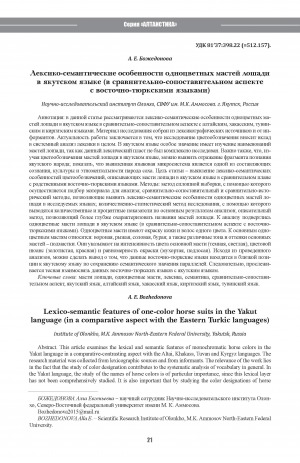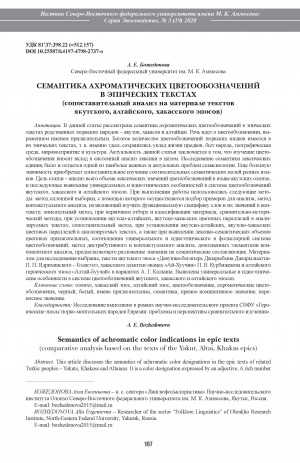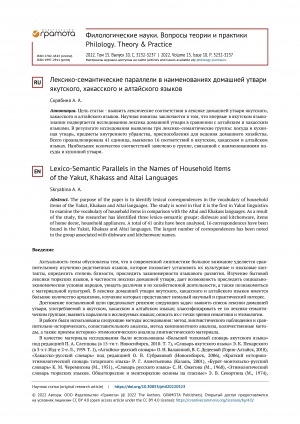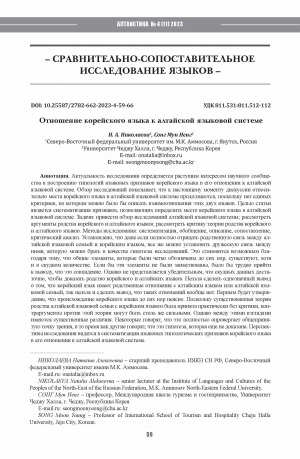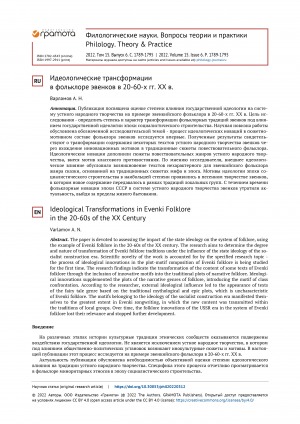Представления о жизненном цикле человека в загадках = Representations of the human life cycle in riddles

Представления о жизненном цикле человека в загадках = Representations of the human life cycle in riddles
Статья в журнале
10.25587/2782-4861-2024-4-95-105
Вестник Северо-Восточного федерального университета им. М. К. Аммосова. Серия "Эпосоведение". - 2025. - N 1 (37)
Данная статья посвящена выявлению возрастных характеристик человека в якутских загадках с привлечением аналогичных единиц тувинского, алтайского и хакасского языков. Актуальность исследования данной проблемы связана с перспективностью сравнительно-сопоставительного изучения феномена загадочных текстов с точки зрения комплексного изучения малого жанра фольклора в разных культурах в русле современных лингвистических направлений (когнитивная лингвистика, лингвокультурология, фольклористика). В работе применяются: метод сплошной выборки, лингвокультурологический и интерпретационный анализы. Материал для анализа извлечен методом сплошной выборки из сборников народных загадок, из работ отдельных авторов, снабженных переводом на русский язык "строка в строку" для удобства работы. Цель работы заключается в выявлении и описании универсальных и национально-специфических представлений о жизненном цикле человека, завуалированных иносказательно в энигматических текстах. В ходе проведенного исследования выявлено, что в данных текстах возможны непрямые номинации загаданного денотата в разных структурных конструкциях, оформление которых зависит от интенции адресанта и адресата. Выявлено также, что в загадках с многочленной структурой кодируется метафорический образ человека в возрастных трансформациях с самого рождения до последних дней. В загадках с двухкомпонентной структурой ход жизненного развития человека представляется как мгновенная смена суточного времени (утро>день>вечер). Такая метаморфоза времени обнаружена в загадке о человеке, которая оказалась универсальной для рассмотренных лингвокультурных сообществ. Как показывает материал, загадочное описание объекта представлено в якутских примерах в акциональном, темпоральном и цифровом кодах, а в рассматриваемых тюркских языках – в зооморфном, цифровом, артефактном и социальном кодах, т. к. загадочные тексты содержат информацию, которая отражает лингвокультурную картину мира, к которой они принадлежат, их дешифровка, разгадка строится на сообразительности, жизненном опыте, знаниях, представлениях об окружающем мире. Перспектива дальнейшей работы видится в более детальном и углубленном осмыслении природы народных и современных загадок с целью выявления динамики восприятия образа человека на материале родственных языков.
This article is devoted to the identification of human age characteristics in Yakut riddles with the involvement of similar units of Tuvan, Altai and Khakas languages. The relevance of the study of this problem is connected with the prospect of comparative study of the phenomenon of riddle texts from the point of view of a comprehensive study of a small genre of folklore in different cultures in the context of modern linguistic trends (cognitive linguistics, linguocultural studies, folkloristics). In the work the following methods are applied: the method of solid sampling, linguocultural and interpretative analysis. The material for analysis is extracted by the method of solid sampling from collections of folk riddles, from the works of individual authors, provided with a translation into Russian “line by line” for the convenience of work. The aim of the work is to identify and describe the universal and national-specific representations of the human life cycle, veiled allegorically in enigmatic texts. The study reveals that in these texts indirect nominations of the enigmatic denotation are possible in different structural constructions, the design of which depends on the intention of the addresser and the addressee. It is also revealed that riddles with a multi-part structure encode a metaphorical image of a person in age transformations from birth to the last days. In riddles with a two-part structure, the course of a person’s life development is represented as an instantaneous change of daily time (morning>day>evening). This metamorphosis of time is found in the riddle about a man, which turned out to be universal for the considered linguocultural communities. As the material shows, the enigmatic description of the object is presented in Yakut examples in actional, temporal and digital codes, and in the Turkic languages under consideration – in zoomorphic, digital, artifactual and social codes, since the enigmatic texts contain information that reflects the linguocultural picture of the world to which they belong, their deciphering, unraveling is based on cleverness, life experience, knowledge, ideas about the surrounding world. The prospect of further work is seen in a more detailed and in-depth understanding of the nature of folk and modern riddles in order to identify the dynamics of perception of the image of a person on the material of related languages.
This article is devoted to the identification of human age characteristics in Yakut riddles with the involvement of similar units of Tuvan, Altai and Khakas languages. The relevance of the study of this problem is connected with the prospect of comparative study of the phenomenon of riddle texts from the point of view of a comprehensive study of a small genre of folklore in different cultures in the context of modern linguistic trends (cognitive linguistics, linguocultural studies, folkloristics). In the work the following methods are applied: the method of solid sampling, linguocultural and interpretative analysis. The material for analysis is extracted by the method of solid sampling from collections of folk riddles, from the works of individual authors, provided with a translation into Russian “line by line” for the convenience of work. The aim of the work is to identify and describe the universal and national-specific representations of the human life cycle, veiled allegorically in enigmatic texts. The study reveals that in these texts indirect nominations of the enigmatic denotation are possible in different structural constructions, the design of which depends on the intention of the addresser and the addressee. It is also revealed that riddles with a multi-part structure encode a metaphorical image of a person in age transformations from birth to the last days. In riddles with a two-part structure, the course of a person’s life development is represented as an instantaneous change of daily time (morning>day>evening). This metamorphosis of time is found in the riddle about a man, which turned out to be universal for the considered linguocultural communities. As the material shows, the enigmatic description of the object is presented in Yakut examples in actional, temporal and digital codes, and in the Turkic languages under consideration – in zoomorphic, digital, artifactual and social codes, since the enigmatic texts contain information that reflects the linguocultural picture of the world to which they belong, their deciphering, unraveling is based on cleverness, life experience, knowledge, ideas about the surrounding world. The prospect of further work is seen in a more detailed and in-depth understanding of the nature of folk and modern riddles in order to identify the dynamics of perception of the image of a person on the material of related languages.
Николаева, Т. Н. Представления о жизненном цикле человека в загадках / Т. Н. Николаева ; Северо-Восточный федеральный университет им. М. К. Аммосова // Вестник Северо-Восточного федерального университета им. М. К. Аммосова. Серия "Эпосоведение". - 2025. - N 1 (37). - С. 95-105. - DOI: 10.25587/2782-4861-2024-4-95-105
Войдите в систему, чтобы открыть документ

